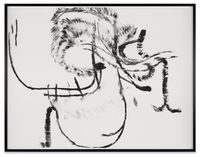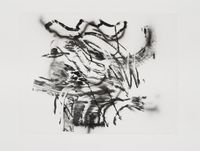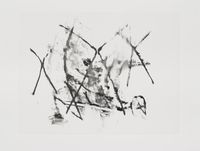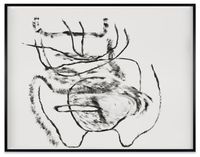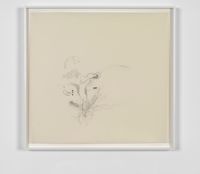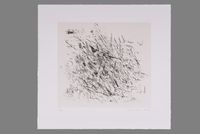Declared one of Time Magazine's 100 Most Influential People of 2020, visual artist and MacArthur Fellow Julie Mehretu's practice explores history, geopolitics, migration, and urban development.
Read MoreThe Ethiopia-born New York artist is co-founder of interdisciplinary arts organisation Denniston Hill (with Paul Pfeiffer and Lawrence Chua).
Mehretu was born in 1970 in Addis Ababa, Ethiopia. When the country's sociopolitical situation began to deteriorate following the 1974 revolution, her family moved to the United States, where Mehretu earned a BA degree from Kalamazoo College and an MFA from the Rhode Island School of Design in 1997.
As a global citizen aware of what it means to be an artist today, the artist says painting is about negotiating who she is and where she finds herself. This is evident in her artworks that have been drawn from politics, literature, news media, and music.
While Julie Mehretu's dynamic, large-scale paintings may appear at first glance to be gestural and expressive, each work contains heavily mediated processes of digital intervention, layering, and erasure.
In 2003, Mehretu presented Empirical Construction, Istanbul, at the Istanbul Biennale as a 'portrait of a city'. In lieu of a depiction of the historic city as a place the artist presented an abstract vortex of arching and angled lines packed with symbols and signifiers of the historic metropolis' past and present.
A product of overlaying, various imagery and documentation the city's architecture and topography the work is an early example of Mehretu's palimpsest collage approach to image-making.
Mehretu begins her paintings by collecting news photographs of public gatherings, protests, natural disasters, and other global events. Using a computer, she collages and manipulates the images beyond recognition before airbrushing them onto canvas in a process she refers to as 'melting'. From there, the images are overlaid with ink, acrylic paint, architectural drawings, and gestural marks.
Even when the original news images are obscured, Mehretu believes their distilled essence imbues the paintings with a level of deep resonance. This method of mediating images represents, she says, how 'history is made: one layer on top of another, erasing itself, consuming itself, inventing something else from the same thing.'
The results of these processes vary greatly from work to work. The intersecting lines and smudges of black pigment in Cairo (2013), for example, resemble a Chinese landscape painting, while the bold washes of colour and scrawls on the surface of Conjured Parts (eye), Ferguson (2016) evoke a kinetic crowd of figures.
The titles of Mehrutu's artworks suggest protest and revolution are particular areas of interest to the artist, particularly given her family's migration in the 1970s.
Exhibited as part of the 2019 Venice Biennale May You Live In Interesting Times, Julie Mehretu's series 'Mogamma (A Painting in Four Parts)' (2011–2012) was inspired by the 2011 Egyptian revolution.
Citing opacity and abstraction as the core of her practice, Mehretu told Ocula Magazine that she considers abstraction as a place 'where one can invent other images or possibilities. It's not about delineating or defining some concrete political perspective, or some directive on how to understand things, or even a historical narrative. It's about the collision of all those things—the uncertainty and murmurings of all that.' Mehretu argues for the right of artists—especially 'Black artists or artists of colour, who are expected to explain who they are and to tell the world their perspectives'—to work in an opaque way that denies reductive categorisation.
Mehretu has, more recently, largely dropped rigorous architectural drawings from her repertoire, and turned toward a pictorial blurriness that represents the cognitive confusion of our times. Emerging from this shift, her solo exhibition about the space of half an hour at Marian Goodman Gallery in New York (2020) featured works that were made during the COVID-19 pandemic.
The works presented in about the space of half an hour were also inspired by the notion of the 'calm before the storm', as Mehretu described to Ocula Magazine in a 2020 conversation. In the photogravure and aquatint work Slouching Towards Bethlehem: Third Seal (R 6:5) (2020), areas of filmy light and shadow behind layers of black scrawls create the illusion of a blurred photograph just out of sight.
In 2005, Mehretu received a MacArthur Fellowship, and the Whitney Museum's American Art Award, and in 2018 received the Liberty Art Award for Artistic Leadership.
Julie Mehretu's has been the subject of numerous solo and group institutional exhibitions.
The artist's solo exhibitions include: about the space of half an hour, Marian Goodman Gallery, New York (2020); Julie Mehretu, Los Angeles County Museum of Art, Los Angeles (2019); Julie Mehretu: A Universal History of Everything and Nothing, Serralves Museum of Contemporary Art, Porto (2017); Julie Mehretu: Grey Area, Solomon R. Guggenheim Museum, New York (2010); Julie Mehretu: Black City, MUSAC-Museo de Arte Contemporáneo de Castilla y León, Léon, Spain (2006); Julie Mehretu: Drawing into Painting, Art Center, Minneapolis (2003).
Julie Mehretu's group exhibitions include: Writing is drawing, The Centre Pompidou-Metz, Metz, France (2021); An Incomplete History of Protest, Whitney Museum of American Art, New York (2017); Divine Comedy, National Museum of African Art at the Smithsonian, Washington, D.C (2015); Seeking New Genealogy – Art, Body, Performance, Museum of Contemporary Art, Tokyo (2014); The Bearden Project, The Studio Museum in Harlem, New York (2011); Comic Abstraction, Museum of Modern Art, New York (2007); Africa Remix, Museum Kunst Palast, Düsseldorf (2004); The Americans, Barbican Art Gallery, London (2001).
Julie Mehretu's Instagram can be found here.
Michael Irwin | Ocula | 2022
